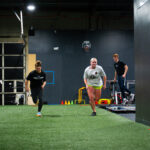Speed and Agility Training for Soccer Players
Soccer is a game of speed, skill, and split-second decisions. To dominate the pitch, players must combine ball control with quick movements and precise footwork. That’s where speed and agility training comes in. It prepares you to move faster, recover quicker, and react smarter in every match.
Why Soccer Players Need Speed and Agility Training
Soccer players constantly change direction, accelerate, and decelerate. Speed and agility training mimics these movements, helping athletes become more effective on the field.
Whether you’re sprinting toward goal or shifting to intercept a pass, agility makes the difference between a near miss and a game-winning play.
Plus, this training enhances balance and reduces the risk of injuries common in soccer—like ankle sprains and groin strains.
Key Benefits of Speed and Agility Training in Soccer
Let’s look at the major advantages soccer players gain from this training:
1. Faster Acceleration and Deceleration
Quick stops and starts are essential during fast-paced play. Drills that simulate these movements build explosive speed.
2. Improved Footwork and Control
Tight footwork keeps you in control during dribbling, passing, and defending. Agility ladders and cones help refine this skill.
3. Sharper Direction Changes
Soccer is fluid. One moment you’re attacking, the next you’re defending. Agility drills train your body to switch directions with speed and stability.
4. Increased Endurance
Agility training improves cardiovascular fitness while conditioning muscles used in every sprint and cut.
Best Drills for Soccer Speed and Agility Training
Choose drills that align with in-game movements and position-specific needs:
Cone Shuttle Runs
Set up cones in a zigzag or T-pattern. Sprint between them, practicing sharp cuts and quick changes of direction.
Ladder Drills with the Ball
Use an agility ladder while dribbling. This develops coordination, control, and speed simultaneously.
Reaction Sprints
Have a partner call out directions while you sprint or change movement patterns. This mimics real-time game reactions.
Box Drills
Create a square with cones. Sprint, shuffle, backpedal, and cut your way around the box to train all movement planes.
More ideas? Check out the NSCA’s guide to soccer performance.
Weekly Soccer Agility Training Plan
Here’s a basic weekly structure you can follow:
-
Monday: Ladder drills + cone sprints
-
Wednesday: Reaction sprints + ball control agility
-
Friday: Box drills + resistance sprint work
-
Saturday (Optional): Position-specific game simulation
Warm up and cool down every session. Always prioritize quality movement over quantity.
Common Training Mistakes
Here are mistakes soccer players should avoid when doing speed and agility training:
-
Ignoring the ball—train with it whenever possible
-
Overtraining without rest
-
Rushing drills and sacrificing form
-
Neglecting flexibility and mobility work
Soccer agility is about control as much as it is about speed. Train with intention.
Integrating Agility Work Into Team Practices
Coaches can easily add speed and agility training to warm-ups or technical drills. For example:
-
Use ladder footwork before shooting drills
-
Start scrimmages with shuttle sprint rounds
-
Add cone agility between passing exercises
At Next Level Athletics USA, trainers customize these techniques for different positions and skill levels to help soccer players reach peak performance.
Pairing Strength with Agility
Speed and agility rely on strength and stability. Add lower-body strength exercises like lunges, squats, and core work to your routine. This provides the power needed for faster acceleration and sharper movement.
Mobility training also keeps muscles and joints limber—reducing injury risk and enhancing range of motion.
Final Thoughts
Speed and agility training helps soccer players excel in every aspect of the game. Whether you’re chasing down a breakaway or weaving through defenders, your movement makes the difference.
Stay consistent, train with purpose, and keep the ball involved whenever possible. Your agility will not only improve—you’ll feel more confident and competitive on the field.


Recent Comments